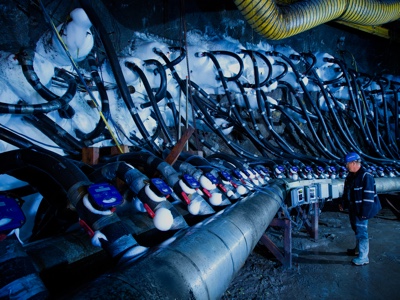Outstanding financial performance – including profitability – is one of our four measures of success, and essential to our long-term sustainability as a company. Our continuing profitability depends on production performance, operating efficiency, and the support of our shareholders and other stakeholders.
Challenges
Like all resource industries, the uranium industry is one that is in constant flux, driven by demand, product availability and a host of other factors. It is a constant challenge to ensure not only our short-term profitability, but also our long-term viability. The ultimate challenge for a company like Cameco is to find a way to balance both these needs. Currently, our industry, and company, faces several significant challenges. They include:
Continued challenging uranium market conditions – While long-term prospects for the uranium market remain positive, current conditions are challenging. A sluggish global economy and flat electricity demand, along with the lingering effects of Fukushima have contributed to a persistent and continued downturn in our industry.
Regulatory and public expectations – Uranium mining and processing is one of the most highly regulated industries in the world. Stringent regulations and oversight govern everything from emissions and waste management to packaging, labelling and safe transportation. The bar is high, and continues to be raised. At the same time, stakeholder expectations of the industry are increasing as issues related to environmental and social governance, including stakeholder engagement, environmental monitoring and resource revenue sharing, gain wider awareness.
Taking Action
In order to ensure we weather the current downswing in the uranium market, we have taken several actions to ensure our long-term success.
The right strategy – pursuing our strategy of focusing on our tier-one assets and managing our supply according to market conditions gives us the ability to weather near-term challenges, benefit when demand rises, and deliver the best value to our shareholders.
Marketing strategy – our contract portfolio is designed to maintain a balance of fixed-price and market-related contracts that optimize our realized price, deliver value and secure a solid base of earnings and cash flow. This strategy has served us well and resulted in an average realized price that consistently outperforms the spot price.
Capital allocation – our priority is to allocate capital in a way that creates the greatest long-term value for shareholders, maintains our investment grade rating and ensures we execute on our dividend policy. We have a multidisciplinary capital allocation team that evaluates all possible uses of investible capital.
Cost reductions – looking for ways to reduce costs without jeopardizing our commitments to sustainability and communities has become a high priority in the current market. We continually look for ways to reduce waste and increase efficiencies across the organization.
Engaging communities and delivering on our commitments – despite the current market conditions, we haven’t changed our commitment to sustainability or to working co-operatively and collaboratively with communities affected by our operations. We know that our social licence to operate has to be earned, and that in practical terms, access to the minerals that our business depends on requires the trust and support of our neighbours. Fortunately, we have a long history of environmental stewardship, impact mitigation and community engagement. Potential new host communities are encouraged to connect with our existing stakeholders, several of whom have had longstanding relationships with Cameco that span generations, to independently verify that we keep our commitments. It’s proven to be a key differentiator in competing for new exploration territory in the Northern Territories in Australia, for example, and signing mutual benefit agreements at Kintyre in Western Australia.

